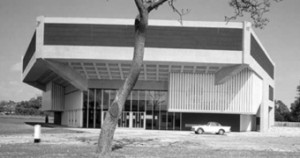
Did you know that the Shakespeare Memorial Theatre in Stratford Upon Avon was designed by Britain’s first female architect? Or that The Old Vic in Bristol is the country’s oldest theatre in terms of continuous use? Or that Laurence Olivier first found himself on a thrust stage by accident; when rain forced a planned outdoor performance of Hamlet at Elsinore into a nearby hotel at the last minute in 1936?
These are just a sprinkling of great facts that poured from Elain Harwood, Senior Architectural Investigator at English Heritage, last Thursday evening (7 November) at Chichester Library as she put Chichester Festival Theatre’s landmark building into a national context. The depth of her knowledge on the subject was breathtaking; Elain began researching post-war theatre buildings in the mid-90s on behalf of English Heritage. It was through this research that she stepped off a train at Chichester station one sunny afternoon and first set eyes on the one-of-a-kind Festival Theatre building. This eventually led to Chichester Festival Theatre being listed at grade 2* status in 1998.

The talk took us through changing auditorium shapes, developments in acoustics, changes to the way theatre buildings were funded after the Second World War, and what happened next for the concept of a the thrust stage.
Auditoriums had been traditionally fan shaped right through to the late 30s, which turns out to be very bad for acoustics. The first specialist acoustician to be working in England, Hope Bagenal, started singing the praises of the rectangular auditorium with a high stage as per many town halls.
In 1948 local authorities were allowed to raise rates specifically for theatre buildings. Theatre’s became a status symbol for a town which led to an upswing in the number being built. Chichester Festival Theatre was in fact the only theatre Elain talked about that wasn’t funded in any part though rates – another remarkable fact on the subject of its founding.
Around this time, the academic world had started to take a new interest in the history of theatre, and this led to greater awareness of the different ways theatre was made in the past. Shakespeare wrote for stages in which the audience surrounded the action on three sides. The influential director, Tyrone Guthrie, in fact became a convert to this thrust stage for performing Shakespeare as a result of that rainy night with Laurence Olivier in Elsinore mentioned above, Guthrie was directing the performance for the Danish Royal Family when, due to the weather conditions they had to retreat into a local hotel ballroom. Seats were hastily assembled around the centre of the room creating an improvised thrust stage for the performance. Guthrie became a driving force behind the creation of thrust stage theatres around the world, including Chichester.
The Chichester ‘experiment’, had a direct impact on designs for the new National Theatre. Elain argued that it was because of Chichester that the National’s radical auditorium, the Olivier with the thrust stage, became its main house, with the more traditional Littleton set up as the smaller theatre.
The talk finished at the Sheffield Crucible, undoubtedly Chichester Festival Theatre’s little sister and familiar to anyone who follows snooker. This was finished in 1971, and after this point theatre design settled down into a more conventional mold. Nevertheless, Chichester Festival Theatre, Elain concluded, belonged to a golden age of theatre building in this country and that, along with its ground-breaking architecture makes it worth protecting!


